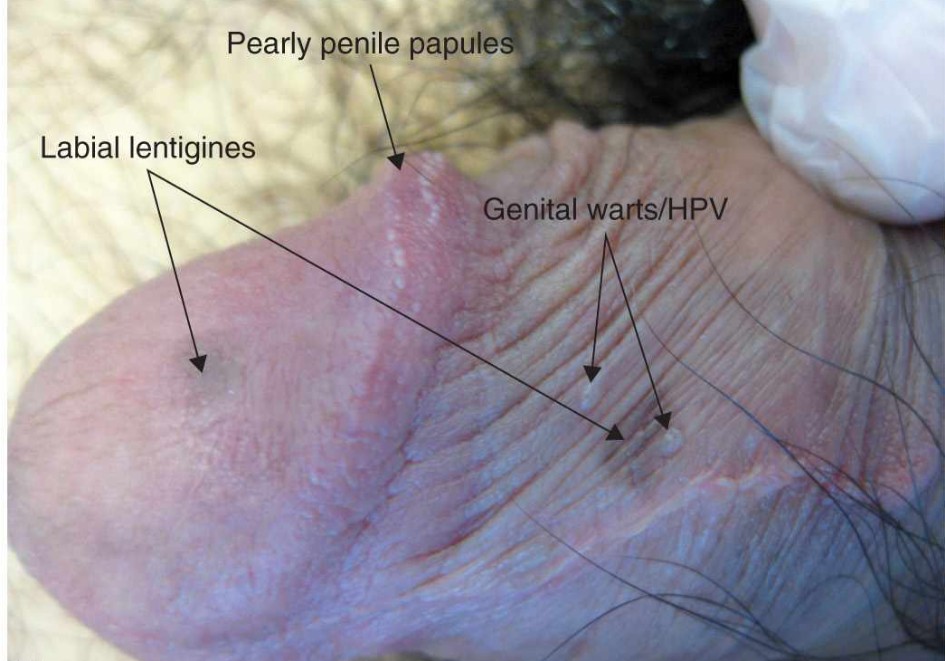
What are Penile Melanosis and Melanoma?
Penile Melanosis
Penile melanosis, also called Lentiginosis is dark brown patches on the penile skin, usually on the upper part of the penis. The spots are flat and large, and each is shown separately.
Genital melanosis is a condition caused by an increase of melanocytes, the pigment-producing cells in the skin around the genital area, however, penile melanosis is very rare as it occurs in 1 out of 80,000 people in a year.
Penile melanosis is a normal condition, not often regarded as an illness as it’s not harmful, not infectious, not often required treatment, and can go away on its own.
Penile Melanoma
Penile Melanoma is a type of cancer that begins in the melanocytes, and can grow gradually or rapidly.
Melanoma can occur on any part of the body, including the eyes, throat, or nose, therefore, penile melanoma is when it grows on the head of the penis or foreskin.
Melanoma is a serious condition that can be life-threatening if not treated promptly.
Like penile melanosis, penile melanoma is not harmful in the initial stage, but it’s important to take note of any discoloration in your penile skin because penile melanoma can grow fast in 3 months, and it can take 1 year to spread fully and advanced to stage 3.
Causes of Penile Melanosis and Melanoma
Causes of Genital Melanosis
There are no certain causes of penile melanosis, but the trigger is the production of more melanin in the skin, which is the source of the main pigment in the skin.
When there is a buildup of melanin on the skin of the penis, that will cause penile melanosis. It may include different pigmented compounds in the skin, like lipofuscin, ferrous sulfate, and hemosiderin.
This can cause dark patches or spots to appear on the skin of the penis. Penile melanosis is benign, meaning it is not cancerous and does not pose a threat to the health of the individual.
Other factors that may intensify genital melanosis are the following
· Genetics: It is possible that the problem of penile melanosis is increasing due to genetic components.
· Age: Also, penile melanosis can impact any age of people, but it is mainly seen in 15 to 72 years old people.
· Skin treatments: The consumption of certain drugs like anthralin can trigger this condition. This can increase the risk factors of penile melanosis.
Causes of Genital Melanoma
Genital melanoma, however, is a type of skin cancer that is caused by the uncontrolled growth of pigment-producing cells (melanocytes) in the penile skin.
Melanoma is one of the severe types of skin cancer which produces melanin, the pigment cell giving the skin its color.
The risk of melanoma is increased in people under the age of 40, there are some triggers of this condition such as the following
- Fair skin: If you have less pigmented skin and can easily have freckles or sunburn, you have more chances of developing penile melanoma. Others are blue or green eyes.
- Sunburn: Having one or more severe sunburns lead to an increase in melanoma risk.
- Excessive exposure to Ultraviolet rays: High exposure to UV radiation from sunlight and tanning beds causes an increase in skin cancer risks, including melanoma.
- History of Melanoma: If some of the members of your family have had penile melanoma or if it has occurred to you in the past, there’s a chance of having it again.
- Weak immune system: People having weaker immune systems have more chances of developing skin cancer, including penile melanoma.
It is very important to protect your skin from UV radiation by wearing sunscreen and protective clothing if you have the risks of melanosis or melanoma.
Symptoms of Penile Melanosis and Melanoma
The symptoms of penile melanosis and melanoma are similar since both conditions are caused by the build-up of melanocytes.
Common symptoms are patches on the foreskin and the head of the penis.
It’s difficult to identify the difference in melanosis and melanoma, but once you notice discloration or patches the skin of your penis, consult your doctor especially when it starts itching you.
Penile melanosis is not dangerous, but penile melanoma can feel hard, painful, lumpy, itchy, and bleed.
In penile melanoma, you can also feel hurt when you’re pressed or try to urinate, and the advanced stage may be difficult to cure permanently.





